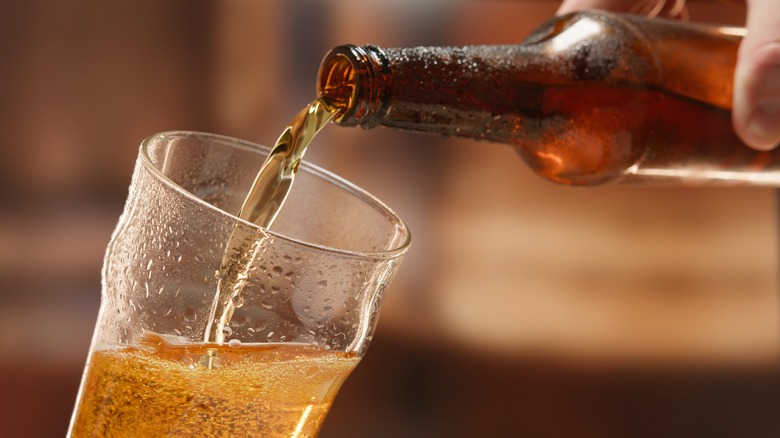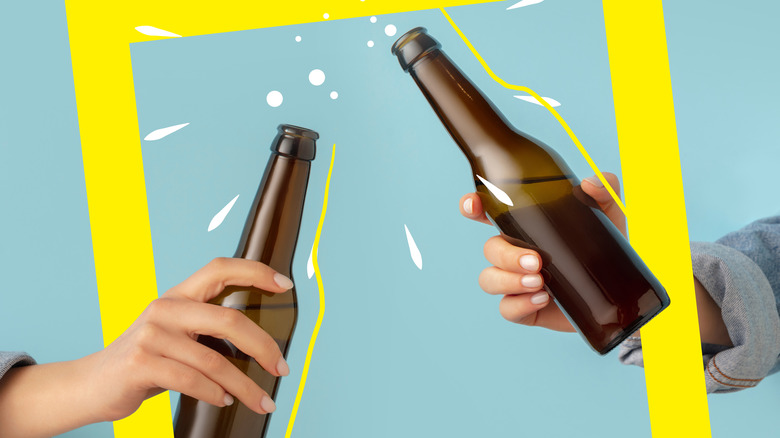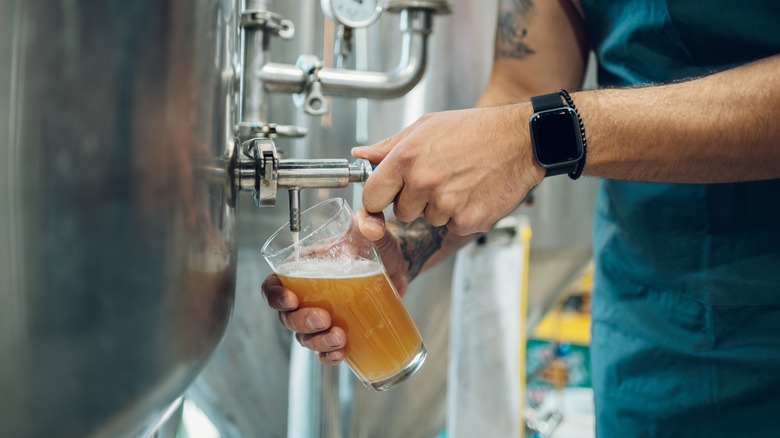Russia Didn't Consider Beer To Be An Alcoholic Beverage Until 2011
When most people think of Russia and alcohol, they probably think of vodka, but according to a 2018 global statistics report from the World Health Organization, the average Russian person drank approximately 11.7 liters, or about three gallons, of alcohol in 2016 with beer and vodka proving to be equally popular, each making up 39% of the total amount consumed. Per Beer and Brewing quoting "The Oxford Companion to Beer," Russian beer history goes back more than 1,000 years with the invention of "kvass," a sweet fermented beverage made from rye bread, flavored with berries, apples, herbs, and spices. However, in modern Russian kvass is produced with a low alcohol content and is more comparable to soda than beer. The Baltika Brewery dominates the Russian beer industry; the first factory was built in 1978 but it didn't produce beers until 1990.
In the early 2000s, the popularity of beer began to overtake vodka in Russia. The Moscow Times interviewed craft brewer Oleg Pivovar who began making beer as a hobby in 2016 and went on to brew about eight tons of beer per month. "Ten years ago I could have never imagined I'd be doing this. Beer was not very popular when I was just starting out. But then everything changed in what I call 'the craft revolution.'" Pivovar went on to note that "hipsters" and younger people want to try things that are new and outside the norm and this includes choosing beer over vodka.
In Russia, beer was a foodstuff
Beer's popularity can also be chalked up to Russia's attempts over the last nearly 40 years to curtail its residents' propensity for very heavy drinking. Quartz reported that in 1985, then-president of the former U.S.S.R. Mikhail Gorbachev responded to reports that men in the Soviet Union had a shorter life expectancy than men in several other countries, including the United States, because of high alcohol consumption and alcohol-related accidents and homicides. He attempted to curtail drinking by raising vodka, beer, and wine prices, cracking down on public drunkenness, and making it illegal for restaurants to sell alcohol before 2 p.m. In rural areas, people started producing a form of moonshine called samogon, but its production required space and privacy not available to city dwellers, who instead started drinking more affordable beer instead of vodka. The anti-alcohol measures lasted until the Soviet Union's 1991 collapse, at which point more beer options became available within the Russian markets.
Furthermore, until 2011, any beer containing less than 10% alcohol, which is most beer, was classified as a "foodstuff" as opposed to alcohol, per the BBC. Not only had beer been marketed as a healthier alternative to vodka, but it could be sold in any store at any time of day and people openly drank it in public much the same way someone might drink bottled water or soda. Then-president Dmitry Medvedev signed a bill that decreed beer sales to be under the same set of controls as hard alcohol sales, which went into effect in 2013.
A dramatic drop in Russian drinking rates
The bill Dmitry Medvedev signed into law prohibited the sale of beer from street kiosks, subway stations, and gas stations, which had accounted for 30% of all sales, and prohibited sales between 11:00 p.m. and 8:00 a.m. as well as all television advertisements promoting beer, per History Daily. This was in addition to the 200% tax hike applied to beer sales in 2010 and 2011 legislation that outlawed the practice of drinking beer in public spaces. According to The Telegraph, Medvedev referred to the abuse of alcohol in Russia as a "national disaster" and officials estimated in 2011 that 500,000 Russian deaths each year were caused by alcohol-related factors. Drinking rates, in general, have dropped sharply in Russia during the 2000s, with the World Health Organization reporting in 2019 that per capita consumption had dropped by a whopping 43% between 2003 and 2016, contributing to a reduction in "all-cause mortality" by 39% in men and 36% in women.
Per Statistica, beer consumption started rising in Russia in the early 2000s, peaking in 2007 with the average Russian person drinking about five liters of beer per year. By 2019, the average had dropped to just over three liters annually. In 2019, BQ Prime reported that there had been an uptick in Russian nonalcoholic beer sales with gains in the double digits, percentage-wise with non-alcoholic beer making up 10% of manufacturer Carlsberg's Russian sales between 2017 and 2019.


